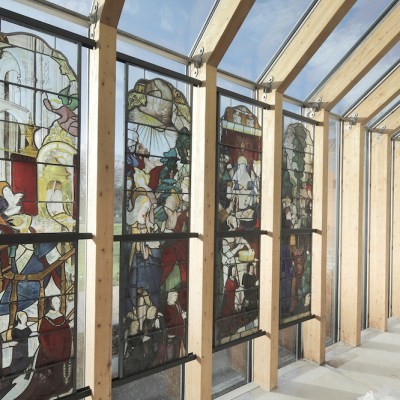
From the May 2025 issue of Apollo. Preview and subscribe here.
When I was moving up here,’ says Caroline Walker, ‘people were joking: “Oh, are you going to start painting sheep?” And ironically, I have!’ We’re sitting at the kitchen table in the artist’s home, an old farm-steading perched on a hillside just south of Dunfermline; Walker and her husband (an architect) have been renovating it for the past four years, finally getting the place habitable enough for their young family to move into just over a year ago. On a day like today, the view from the kitchen window is breathtaking; out over the Firth of Forth, the forms of the three Forth Bridges are stamped like emblems on the spotless mid-March sky, while in the distance on either side the Pentland Hills and the crags and spires of Edinburgh rise and fall. Nearer by, the inevitable lambs are gambolling. It’s not hard to see how an artist could switch London for this corner of Fife and be beguiled into painting rural scenes. All the same, it’s funny to think of this particular artist doing so.
A typical Caroline Walker painting turns our gaze not out, but in. It has us looking into a room, through a doorway or a window or from some nook – from somewhere out of the way, at any rate. In the room there is a woman – often, though by no means always, alone – paying close attention to a task at hand. The task could be almost anything, from changing pillowcases to observing antibodies through a microscope; what remains constant is the quality of attentiveness, the subject’s absorption in doing whatever it is that is being done. By all appearances, she is unaware that she is being observed – and yet, of course, she is. Not just observed, but scrutinised with the utmost care, first by Walker and then, once translated into compositions and brushstrokes as lavish as they are exacting, by the viewer. Attentiveness, these paintings insist, is a thing best shared.
Sticker Dolly Dressing (2024), Caroline Walker. Photo: Peter Mallet; courtesy the artist/Grimm Gallery, Amsterdam/New York/London/Ingleby Gallery, Edinburgh/Stephen Friedman Gallery, London/New York; © Caroline Walker
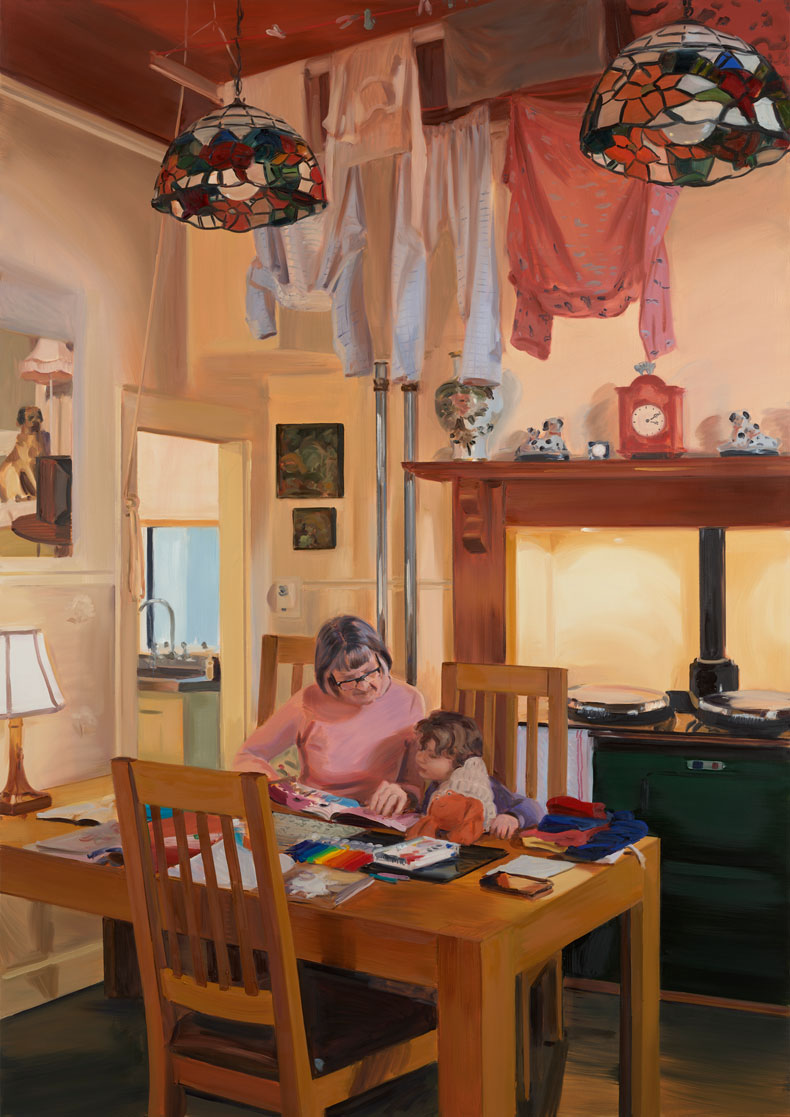
In this fashion, Walker has established herself over the past decade both as one of her generation’s most formally rigorous and imaginative figurative painters, and among the most compelling contemporary voices on the nature and significance of what, historically, has been called ‘women’s work’. These two sides of her success are mutually reinforcing. One definition of women’s work might be the jobs done by women that usually go unnoticed – whether that’s caregiving, domestic chores or, in Walker’s more up-to-date reckoning, biochemistry or surgery. One definition of painting might be that it is an extended act of noticing. When I ask Walker about the politics in her paintings, the word she uses is ‘gentle’. Like so much else, it seems carefully chosen.
In Walker’s studio – a former bothy next to the farmhouse – there hang a couple of paintings in progress. One shows a nursery worker, crouched down beside a group of kids who are mucking around with a multi-piece wooden train track. It’s pretty much finished, Walker tells me. I can see that the light and shade on the faces – and with them, the tender interplay of attentions divided between the worker, her charges, and their train-track – are fully modelled, with what Walker likes to refer to as a ‘buttery’ handling of oil paint. It just needs the foreground filled out and the text of the lesson on the blank blackboard behind them chalked on; Walker says, laughing, that she’s saving this last bit to the very end as a wee treat for herself, ‘like writing on an actual blackboard’. The other is still mostly underpainting, but the bare bones of the composition tell a clear-enough story – of a grandmother’s efforts to aim a hairdryer at a post-bath, pyjama-clad and tenaciously wriggling grandchild. Once dry, both paintings are destined for the Hepworth Wakefield, which from this month is hosting Walker’s largest museum exhibition to date (17 May–25 October; touring to Pallant House Gallery, Chichester, 22 November–10 May 2026). ‘Mothering’ brings together 35 works completed over the past five years – a period roughly synchronous with the life of Walker’s daughter, Daphne, although it would be a mistake to think of these works, grouped as they are around the theme of early-years care, as straightforwardly autobiographical.
‘Before I had children,’ Walker tells me, ‘I don’t think I would have imagined that that was going to become such an important subject for me. If anything, I would have thought that I would have tried to resist it quite heavily – even though women’s experience and women’s work had been at the fore for a few years.’ And yet, she says, ‘each stage of having a baby, and then small children, seemed to open up a new world that I had no access to previously.’ Each of these ‘new worlds’ is sustained by its own peculiar tasks, and the shifting cast of characters who perform them. The works in ‘Mothering’ span ante- and neonatal doctors and nurses measuring, monitoring, cradling; nursery staff directing toddlers in reading, painting, sensory play and cleaning up; Walker’s sister-in-law, Lisa, changing nappies or administering night-time feeds; Walker’s mother, Janet, sitting at the table with Daphne, doing sticker books; Walker herself, in a rare self-portrait, holding her younger child Laurie before a mirror.
Earlier in her career, Walker had worried that ‘anything personal wouldn’t have universal resonance’. But the scenarios in these paintings are ones that any recent parent can recognise and respond to viscerally. One little oil-on-board painting, My Bottles and Pumps (2024), simply shows a tower of plastic teats and the fiddly little detachable bits of breast pumps, freshly washed and sterilised and drying in the sink rank. They appear as totems to a chore that in the first weeks of a baby’s life needs doing again and again and again – Walker likens it to a ‘ritual’ – but which is unlikely even to be mentioned when friends or family ask about life as a parent.
My Bottles and Pumps (2024), Caroline Walker. Photo: Peter Mallet; courtesy the artist/Grimm Gallery, Amsterdam/New York/London/Ingleby Gallery, Edinburgh/Stephen Friedman Gallery, London/New York; © Caroline Walker
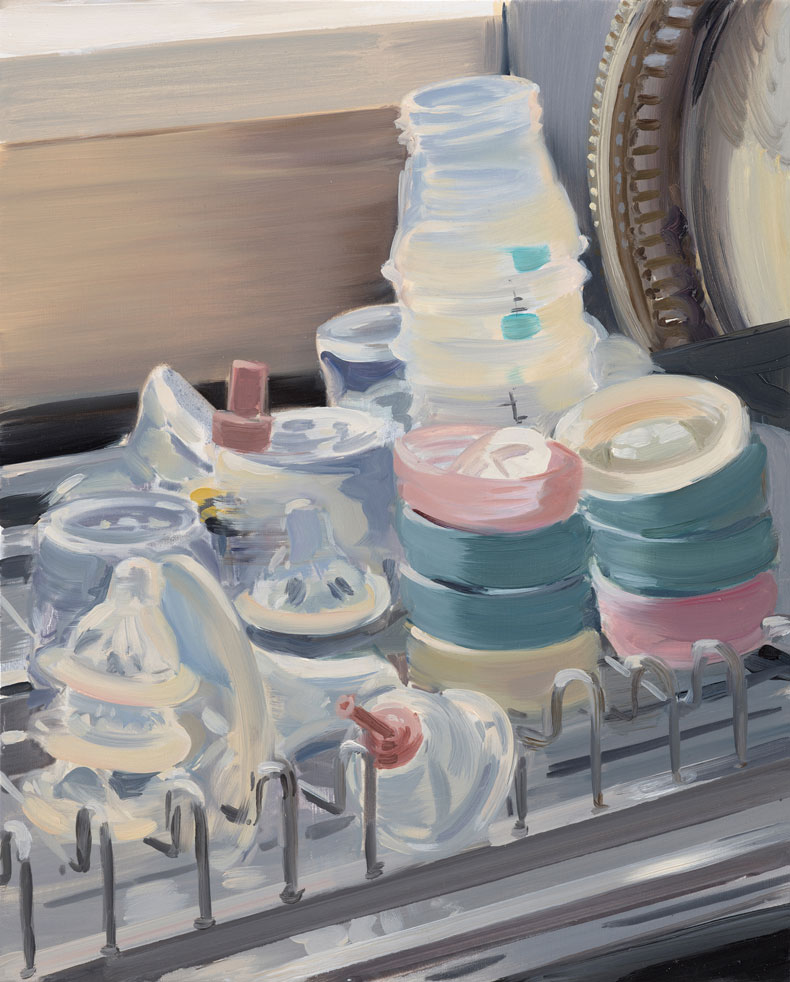
What Walker has is a knack for identifying the intimacy of moments and objects that usually go unremarked. Ironically, it’s a knack that it took her a long while to notice. As a child growing up in Dunfermline, she was ‘always mad for drawing and painting’, so it was a straightforward decision to go to art school – and specifically the Glasgow School of Art, ‘because it offered a painting course, rather than general fine art’. Moyna Flannigan and Carol Rhodes were inspirational early teachers, and there were a lot of the ‘older generation guys’ still knocking around, painters such as Alexander Moffat, in whose studio the students might be invited to share a whisky after life-drawing classes. ‘By the time I graduated in 2004,’ Walker says, ‘painting was much more fashionable again’ – though, oddly, not in Glasgow, where conceptual art still ruled the roost. In 2007, after three years odd-jobbing and painting in between, she moved to London to begin a master’s in painting at the Royal College of Art.
By chance, at the RCA Walker started working closely with a peripatetic life-model – ‘She didn’t really have a home, so moved around different people’s houses, dog- and cat-sitting. I would go and visit her in these different places and paint her, and I became interested in the ways that she was this constant, but the setting kept changing. I started to become interested in how narrative is constructed – I suppose I was thinking of it in a kind of filmic way.’ Walker mentions David Lynch and Hitchcock as influences at this time – but more than ‘specific films’, she was thinking about ‘props, characters, lighting […] what each of those things did, and what happened when I changed one of them.’
Over the course of the next decade, the stage-managing became more and more elaborate – ‘outlandish’, Walker calls it. This way of working came to a head in 2017; Walker was in Los Angeles, co-ordinating photoshoots with a former Miss America contestant for what would become her Sunset series, following a day in the opulent life of a fictionalised woman living in the Hollywood Hills. ‘There was so much pressure on these photoshoots, to get the material that was going to generate a year’s worth of work – it was really expensive, I was having to think on the spot really quickly. Everything was coming from me – what is this story? Who is this woman? I was starting to run out of steam.’
Desayuno (2017), Caroline Walker. Photo: Peter Mallet; courtesy the artist/Grimm Gallery, Amsterdam/New York/London/Ingleby Gallery, Edinburgh/Stephen Friedman Gallery, London/New York; © Caroline Walker
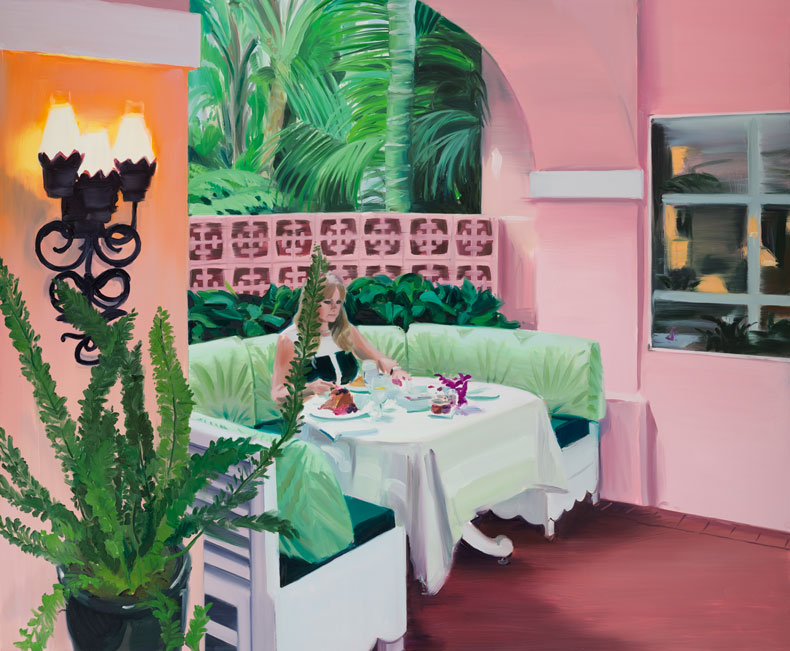
Providentially, at this moment a commission arrived that ‘transformed my whole attitude to work’. It came from Andrew Nairne, the director of Kettle’s Yard in Cambridge, who asked Walker whether she might like to make a body of work in response to the refugee crisis. She thought long and hard – ‘You know, it’s a really big subject that I have no personal experience of’ – and decided that if she was going to do it, it would have to be grounded in the experience of women in London. So she met with a group from a local charity, Women for Refugee Women, who were initially a little wary: ‘“Your works show beautiful lives; our lives aren’t like that.” You know, they didn’t want to be portrayed in a way that was not representative of reality – and I came away in total agreement. I felt that if we were going to do this, I had to be working in such a different way – it’s me responding to you, rather than directing anything.’
In the series that would be exhibited as Home (2017–18), a woozy Californian palette is muted into something humbler; sun-loungers are swapped for institutional iron bedsteads. In getting to know the refugee women in south London she would document in these paintings, Walker says she realised ‘that I didn’t need to make up anything. Real life’s actually much more interesting and engaging – and you don’t have to have the same experience as somebody to have empathy for their position, or to see something in it that you see in your own life.’
None of this is to suggest that the Home paintings, or those that came after, pretend to represent a reality that is raw, or unfiltered. In Tarh, 11.45am, Southall (2017), we are looking through two sets of bright red doors as Tarh quietly makes herself a cup of tea. The open doors simultaneously work as a repoussoir, leading the eye in, while also crowding the composition, corralling the activity beyond them into a claustrophobic space that chimes precisely with the cluttered state of the kitchen counter. On the doors are those little blue circular ‘Fire-Door’ signs that immediately tell the viewer – at least if they’ve spent any time in the UK – that we are in an institution. ‘So you get a sense,’ Walker says, ‘that this is a temporary space – it’s not somewhere these people have had the chance to make their home properly.’ This, then, is reality carefully organised to tease out its narrative or symbolic significance – and all those years of directing fictionalised dramas were important preparation. ‘It’s the same toolkit,’ Walker says.
Tarh, 11.45am, Southall (2017), Caroline Walker. Photo: Peter Mallet; courtesy the artist/Grimm Gallery, Amsterdam/New York/London/Ingleby Gallery, Edinburgh/Stephen Friedman Gallery, London/New York; © Caroline Walker
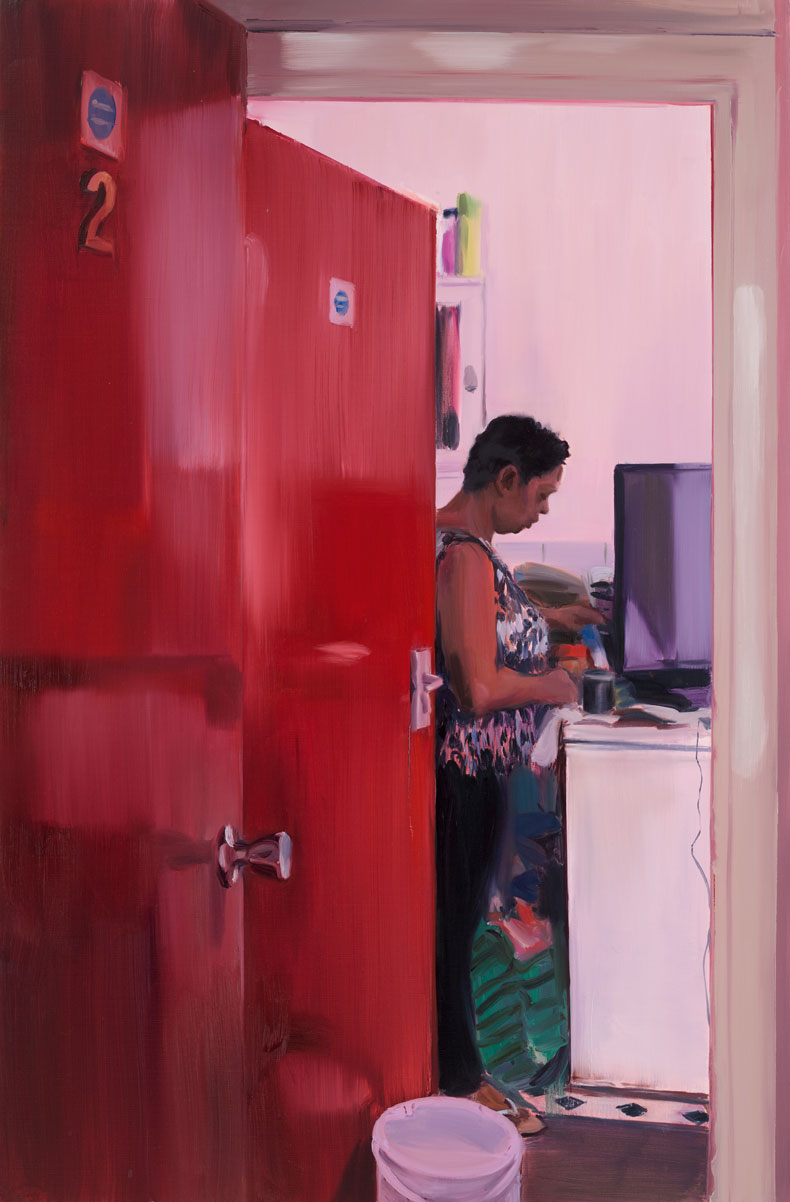
In the years since, Walker has managed to both broaden and deepen her approach, consolidating the intensity of her focus while seeking out an impressive variety of subjects. Housekeeping (2018) depicted the work of cleaners in the hospitality industry; Janet, a series of works that follows her mother around the house and garden, was shown to great acclaim at Ingleby Gallery, Edinburgh, in 2020, and the following year she completed her Birth Reflections series, the product of a residency at a London maternity ward that coincided with Walker’s own pregnancy with Daphne. Curiously, the more personal Walker’s subjects have become, the more subtle her engagement with the nature of painting as artifice. ‘Voyeurism’ is a word that critics have often used to try and explain the difficult question of what, exactly, the viewer’s role is – spying from the window or through a doorway, or landed in the midst of a scene such as a nursery or an operating theatre that is usually strictly private. The word is too ‘threatening’, Walker says – ‘but there is a fiction going on. You know, with the paintings of my sister-in-law feeding the baby in the darkened room at night [the Lisa paintings; 2022] – that’s a solitary activity, but I’m there, I’m in the room. So there’s an illusion – but that’s always there anyway, because we’re making paintings, which are always a construction after the fact.’ Walker is currently ‘obsessed’, she says, with Berthe Morisot’s Wet Nurse Angele Feeding Julie Manet (1880) – ‘the way it’s executed’, on the one hand, but moreover ‘the social situation it’s setting up: this working woman paying another woman to nurture her child so that she can do her work, which is in fact representative […] You know, in my work about nurseries, it’s often my child that I’m observing being looked after by another in exchange for money – there’s the question of how these different forms of labour are valued.’
Beyond the dynamics of looking, Walker’s engagement with art history is as instinctual as it is deeply studied, allowing her to inhabit fully the long tradition of realist painting that extends via Manet and Morisot back to the genre paintings of the Dutch 17th century. Theatre (2021), the largest of the Birth Reflections series, now hangs in the Scottish National Portrait Gallery. It shows an operating theatre in which a Caesarean section has just been performed. By all rights, this ought to be a scene of feverish activity – and yet, in Walker’s hands, it becomes one of beatific stillness. The eight medical staff are arranged so that the forms are held together with the rhythmic grace of a carved frieze; the whole composition can be seen as a series of recurring triangles, comprising arms, the fabric of surgical gowns and the spaces between them. Among Walker’s most ambitious compositions, at 3.5m long, it combines the grandeur of history painting with the fervour of the Virgin and Child (she points out the ‘blue cloth that presides over everything’). The brushwork feels both intuitive and calculated: the calm, loving look the new mother casts towards the little neonate being measured across the room dissolves into a whorl of enigmatic brushstrokes the closer you get; some of the brushiest passages are reserved for the hard, plastic surgical containers in the centre of the painting, rushing the eye over them. ‘Because I work with photographs,’ she explains, ‘you can end up with an overallness to the paint surface – so I consciously think about different ways to use the paint in different parts of the painting. That’s what late 19th-century painters do again and again and again – you know, when you’re 10 metres away and it looks like a very described figure but then you get closer and it’s actually just a construction of paint. That’s when I start getting quite excited.’
Theatre (2021), Caroline Walker. National Galleries of Scotland, Edinburgh. Photo: Peter Mallet; courtesy the artist/Grimm Gallery, Amsterdam/New York/London/Ingleby Gallery, Edinburgh/Stephen Friedman Gallery, London/New York; © Caroline Walker
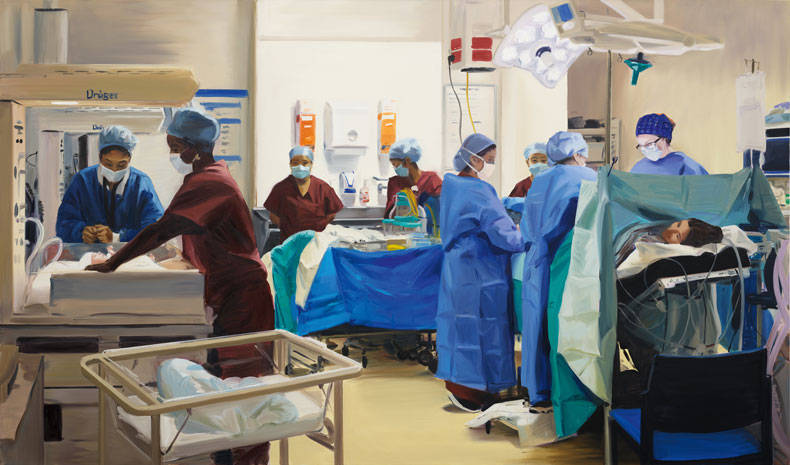
Theatre is a work that on numerous levels dramatises the relationship between painting and experience – the ways that each can prove a filter for the other. I get the feeling, speaking to Walker, that painting has become, at least on one level, a means of giving structure to her life; she sifts through the photographs she has taken of her family and their support networks, sometimes after what she calls a ‘lag’ of months or years, sorts them according to palette, or shape, or mood, and sets methodically to work. Yet her paintings also prove that experience tends to defy whatever limits are imposed upon it. Since moving to Fife, as well as looking out the window she’s been looking at the paintings of the Glasgow Boys – ‘this Scottish quality to the landscape: the weather, the colour palette’ – and become friendly with a neighbouring couple who farm sheep. So far, she’s made ‘a couple of small paintings’ of the wife rearing lambs.
‘Caroline Walker: Mothering’ is at the Hepworth Wakefield from 17 May–27 October.
From the May 2025 issue of Apollo. Preview and subscribe here.